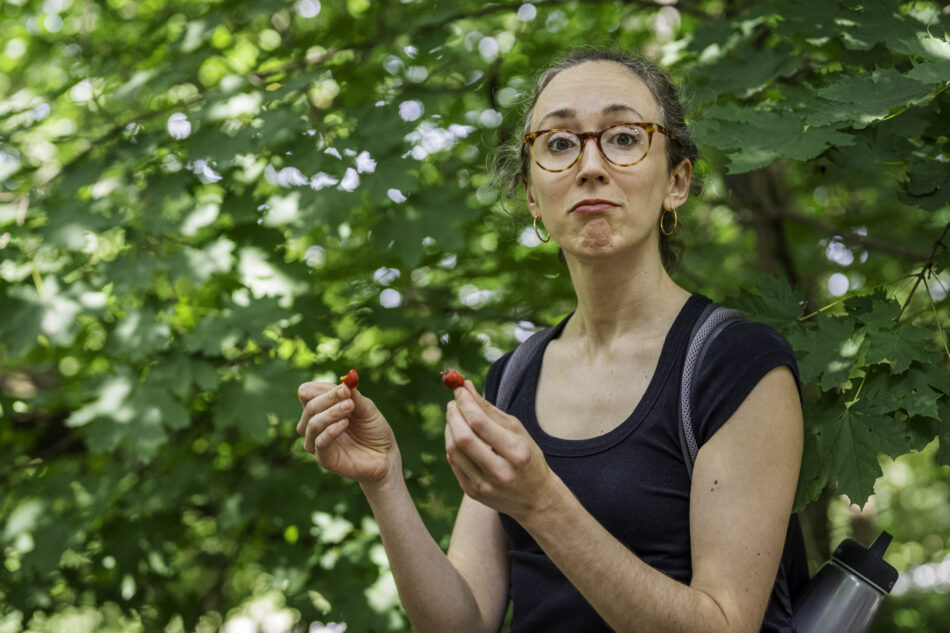On a Saturday morning in mid-August at the northern tip of Prospect Park in Brooklyn, the weekly farmers market sprawls across the plaza. White tents house pyramids of canteloupes, heaps of spinach and chard, and pint containers of blueberries and raspberries that stretch in rows like so many orderly jewel boxes.
Though less obvious to the untrained eye, an edible bounty that rivals the market also waits inside the boundaries of the park.
I’m here to attend a tour of this bounty — my fourth foraging tour with “Wildman” Steve Brill, the undisputed authority on the edible flora of the concrete jungle. Steve has been introducing New Yorkers to the wild foods between Broadway and the Bronx for decades — first without, and then with, the city’s blessing. In 1986, he was arrested by two parks-enforcement patrol officers who’d disguised themselves as ordinary people to attend his tour and who alleged that foraging would deplete Central Park of its plants — this despite the fact that Steve focuses on what is plentiful or invasive. His arrest made headlines; soon after, the city dropped the charges and hired him as a naturalist for four years.
I’ve attended Steve’s tours in spring and fall, but never in this shoulder season, when the summer sun is still blazing but cool breezes that portend change brush through the city’s streets. I’m itching to learn what’s on the August menu.
The Wild Salad Bar
Steve starts the tour for the group of 18 amateurs that has gathered with his classic warning to avoid toxic lookalikes, delivered as a deadpan rendition of Chopin’s funeral march. That out of the way, we’re off, following a sidewalk that curves into the northwest end of the forested park. We haven’t walked more than a few hundred feet when we encounter our first snack of the day: the dourly named goutweed, an invasive groundcover plant with small, bright green, curled-under leaves growing in a sprawling patch. I crouch to pluck some and chew a few leaves: They taste like parsley, celery, and carrots rolled into one. I mentally plan a pesto.
Next, growing on a hillside, we find Lady’s Thumb, another invasive whose leaves taste like very little but have a crazy textural thing going on, gelling in my mouth in a way I don’t seek to repeat. (“Good for thickening soups!,” Steve says.)
The same hillside sports invasive burdock, so Steve tells the tour-goers who brought spades to start digging around the plants’ broad leaves. While a few people excavate the tuber-like roots, which can be pickled, steamed, or sliced and deep-fried into tempura, I lock eyes with my favorite wild green, yellow wood sorrel, a weedy plant I learned about earlier this year. Despite looking like clover that’s hit a gangly teenage growth spurt, yellow wood sorrel has a flavor that is all elegance — lemony and crisp.
We round out our wild salad bar when we spot garlic mustard, an invasive, and poor man’s pepper, a plentiful native plant, growing behind nearby park benches. The leaves on poor man’s pepper are sharp and spicy — a billion times better than the bland arugula on offer at the supermarkets near me. The garlic mustard plants we find are withered and seeding, since they’re nearing the end of their lifecycle. We rub the stems together like we’re trying to start a fire, and mustard-flavored seeds rain down into our Tupperwares.
The Fruit Course
As we push deeper into the park, Steve breaks some tough news: We’re unlikely to find berries or cherries because of a late-spring frost that killed some of the blossoms this year. Spring weather in the northeast has been getting more chaotic because of climate change, throwing off berry and stone-fruit harvests more often. All the more reason to acquaint oneself with what else grows wild here. Diversity is resilience, after all.
But we soon spot a crabapple tree leaning over the edge of Prospect Park’s paved bike loop, its nearly bare boughs weighed down with what look like hundreds of Christmas baubles. Stepping out of the way of a roller blader, I pick an apple and bite in: It’s pink all the way through and tart-sweet.
We find a hawthorn tree on the same path, its burgundy fruits tasting and looking like crabapples to me. An easy way to tell the difference, Steve says, is the number of seeds: Crabapples have five, while hawthorns have just one. All I need to know is they both make a mean crimson jelly (whether you have crabapples or hawthorns).
The After-Dinner Drinks
Back on the walking path, right as we pass a couple being pulled along by two fancy poodles, Steve stops short, fixated on an empty patch of dirt under tall trees. “Kentucky coffeetree beans,” he says, pointing. At first, I see nothing. But then, out of the dirt and mulch, I start to see dozens of smooth, pebble-like, dark-brown seeds. I pick one up and rub the dirt off it. It doesn’t smell like anything — yet. To turn these seeds into a caffeine-free coffee substitute, Steve tells us, you roast them and grind them up, mixing in a third of real coffee beans.
We come across a black birch tree next, the inner bark of whose twigs exude wintergreen oil zingier than any stick of gum, and then a spicebush shrub, which I silently freak out over because I’ve been wanting to spice cakes with its allspice-flavored berries for years. A native plant commonly used in Indigenous cuisine, spicebush shrubs produce red berries that ripen in early fall, so for now we just take the leaves to make tea.
I’ll have to come back for the berries, I think, adding them to my mental list of wild edibles that’ll be ready for snacking as the temperature drops: black walnuts, hickory nuts, mushrooms, hazelnuts, northern black haw berries — the list goes on. The farmers markets may falter as fall sets in, but the Big Apple’s parks keep on giving, if you know where to look.
For NYC Foragers
Many trees bearing edible fruits, nuts, and leaves (such as crabapple and black walnut) can be located on this Prospect Park Alliance tree-keeper map. Just be doubly sure what you’re picking before you eat it!
Tips for Foragers
- Forage responsibly: Focus on plentiful or invasive plants to avoid depleting the area.
- Avoid toxic lookalikes: Always be sure what it is you’ve picked before you eat it.
- Bring the right gear: Bring gloves for extra protection and make sure you bring the proper tools for harvesting. Some plants, like burdock, require spades to excavate their roots.
- Learn to identify plants by their characteristics: For example, crabapples have five seeds, while hawthorns have one.
- Learn about foraging from Rebecca Gilbert, the Foraging Farmer. Check out her book Weedy Wisdom for the Curious Forager: Common Plants to Nourish Your Body & Soul (on Amazon).
- Find foraging in your area with FallingFruit.Org.









